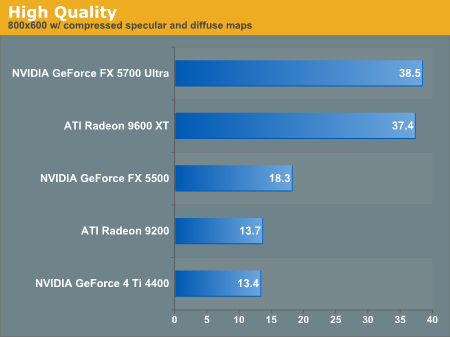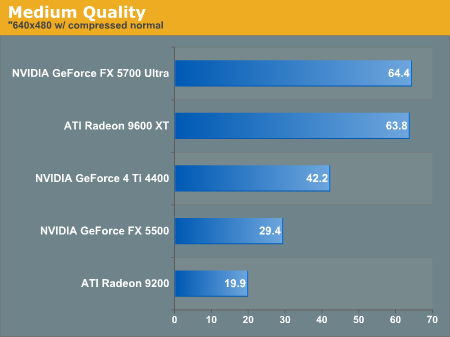Low End Tests: Last Man Standing
And finally, we have the low end budget cards and previous generation equipment. We ran these tests at the default resolution set by each of the first three quality settings. We ran the High Quality setting, as last years midrange cards almost make our playable frame rate list. For some, this may be close enough, but we really want to see that 40-45 frames per second average before we call it rock solid.At Medium quality, the GeForce 4 Ti 4400 falls in our playable range, which is very impressive for such an old card. Medium quality still looks great, and even with the quantization visible on lighted surfaces (especially in specular highlights) is still aeons beyond what one would expect this venerable card to handle. The id team has certainly out done themselves with quality support for previous generation hardware while building in plenty of scalability.
Though we didn't test it here, the best setting for both the 5700 Ultra and 9600 XT is Medium Quality at 800x600, as it gives the best performance and balance of visual experience.
Another bit of goodness to take away from these tests is that Low Quality and Medium Quality really don't show a tangable difference on these cards. There is absolutely no reason to run Low Quality on any card that has more than 64MB of RAM. This means that textures won't be resized, though some quantization may be evident from the compression used on normal, specular, and diffuse maps.













71 Comments
View All Comments
DerekWilson - Wednesday, August 4, 2004 - link
Essobie:Between the High Quality at 1024x768 graph and the High Quality at 800x600 graph (in the Low End performance analysis), you can see that the 5700U and 9600XT scale a little more than 10fps when dropping res. This number is bigger for higher performance cards. We should have included a couple of last years high end cards in that graph. Sorry for the omission.
Essobie - Wednesday, August 4, 2004 - link
I sure would have liked a comparison for ALL the mentioned cards in a few of the different settings side by side. The idea that you can choose what card is right for you can't both be expressed by visual quality and frames per second in three seperate teers.What I'd like is to see what the best card for the buck is going to be that will run the game around 60fps in 800x600 with all graphical nicities on. As it is now, I have to just make a judgement call on what the Mid-Range results show, even though the difference in performance between 800x and 1024x are likely to differ in the 10-20 fps level, if I am assuming correctly.
I love the article, but it would be nice to simply find 'how' I want to play the game, and then see what performs best at those settings. Maybe it's just that none of their settings match what I think is really important. :(
kherman - Wednesday, August 4, 2004 - link
ATI 9600 SE, using a 2800+ athlon. Not sure of memmory, etc. Have 512 meg though. Latest non-beta ATI drivers.640x480 med - 26.8 fps
I can't wait to post my 6800 numbers ;)
Sonic587 - Wednesday, August 4, 2004 - link
Thank you, PrinceGaz. Very interesting results. Have you tried OCing any of your hardware? Decent FPS considering you have PC2100 and a 1800+. All this with a 4200 at stock!PrinceGaz - Wednesday, August 4, 2004 - link
I should add that those framerates were measured by doing four runs at each resolution and quality setting, discarding the first run, then taking an average of the other three (they were very consistent and only varied by one tenth of an fps between the second, third and fourth runs). High quality really was marginally faster than Medium, when Aniso was off.PrinceGaz - Wednesday, August 4, 2004 - link
To run the timedemo, at the console type "timedemo demo1.demo". If you want to see the fps in the top-right corner while playing, type "con_showfps 1".I tested my system a couple of days ago using the timedemo (XP 1800+, 768MB PC2100, 128MB Ti4200 @ 250/500 Det 56.72). All Advanced settings were at the defaults (all enabled except for VSync):
640x480 low - 31.4 fps
640x480 med - 31.3 fps
680x480 high - 23.4 fps, or 31.4 fps if Aniso forced Off in the driver (the game requests 8x Aniso on High setting)
800x600 low - 28.2 fps
800x600 med - 27.9 fps
800x600 high - 28.0 fps with Aniso forced Off
1024x768 low - 21.6 fps
1024x768 med - 21.2 fps
1024x768 high - 21.2 fps with Aniso forced Off
There is no real difference in framerate on a 128MB Ti4200 between Low, Medium, or High quality, except for the 8x Aniso used in High quality mode which cripples older generation cards. Force Aniso off and you can use High quality with no drop in framerate. The optimum balance of resolution and framerate for my system while playing was 800x600 which played surprisingly well and looked a lot better than I expected.
cosmotic - Wednesday, August 4, 2004 - link
Actually, GF4MX has no shader support, so its not at all like the GF3. Last card without shader support was GF2s. I was right, according to nVidias website, the only thing it has over the GF2MX is antialiasing... And maybe their light speed memory architecture, video processing engine (DVD) and nView, although I dont know it the GF2MX had that or not.Detritis - Wednesday, August 4, 2004 - link
From various stories that I have read regarding framerates in Doom 3, I was under the impression that it was going to be capped at 60 fps. However there is a couple of time that some cards break 70 and even 100!Sonic587 - Wednesday, August 4, 2004 - link
How did the GF Ti4400 do @800X600 medium quality? Not to be nitpicky, but it's well known that AF will kill any GF4 series card.Crassus - Wednesday, August 4, 2004 - link
Thx for including the GF4. I don't really know why the 4400 though, as the 4200 was sold in way higher quantities. Good to see though that it can run DIII decently.